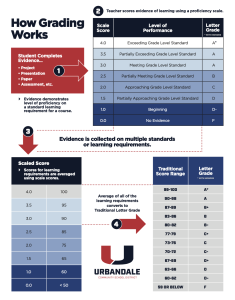Grading for Learning
Background
The creation of the Urbandale Community School District’s 2013 strategic improvement plan identified multiple opportunities for strategic improvement throughout the UCSD system. One of these, monitoring and effectively communicating student learning, identified gaps, inaccuracies, and inefficiencies with the traditional system of reporting student learning. Grading for learning, or basing student grades on demonstrations of learning, is consistent with best practices and widely supported in current educational literature.
In 2015-16, a diverse team of Urbandale educators representing K-12 teachers, teacher leaders, and building and district administrators embarked on a study of current and best practices with respect to grading students’ learning. This “Grading for Learning” team developed guiding principles for evaluating and reporting student learning. These guiding principles, based on their extensive research and work, are outlined in this handbook.
The UCSD mission of “teaching all, reaching all” will be fully realized when each student demonstrates high levels of learning in every classroom, every day. In order to do this, classroom systems with high expectations and learning goals for every student that are structured around continuous improvement cycles of instruction, assessment, and feedback are necessary. Providing stakeholders with fair, accurate, specific, and timely information regarding student progress toward high standards of learning, as well as feedback for growth, is the aim of grading for learning in UCSD.
| Accurate | Grades represent student learning on predetermined curriculum standards. Non-academic factors, while important, are reported separately and not part of the academic grade. |
| Fair | The same level of student performance receives the same grade, even if the teachers are different. |
| Specific | Grading criteria and learning goals should be so clear that students can accurately determine the grade they earn, even before it is evaluated by the teacher. |
| Timely | Feedback to students is so timely that students can use it to improve their performance on upcoming practice and assessments. |
We use grades to communicate a student’s path toward learning requirements.
- Grades are aligned to the academic standards for a course.
- Grades are based on a body of student-produced evidence.
- Determination of a grade is based on established proficiency levels, which describe academic learning and levels of performance aligned to course/grade-level standards.
- Grades are based on a student’s demonstrated achievement of course/grade-level standards. Achievement of behavioral objectives is important enough to report separately and does not factor into the academic grade.
We use the Building a Better U Rubric to communicate a student’s path toward positive interactions and personal responsibility.
- Building A Better U Grades K – 2
- Building A Better U Grades 3 – 5
- Building a Better U Grades 6-8
- Building A Better U Grades 9-12
Beginning the fall of 2022, grades 9-12 began to implement Grading for Learning. Below is specific information regarding grading and the traditional letter grade is assigned based on a student evidence of learning.
For more information, please refer to the 9-12 Grading for Learning One-Pager
For more information, please refer to our Grading for Learning Manual





